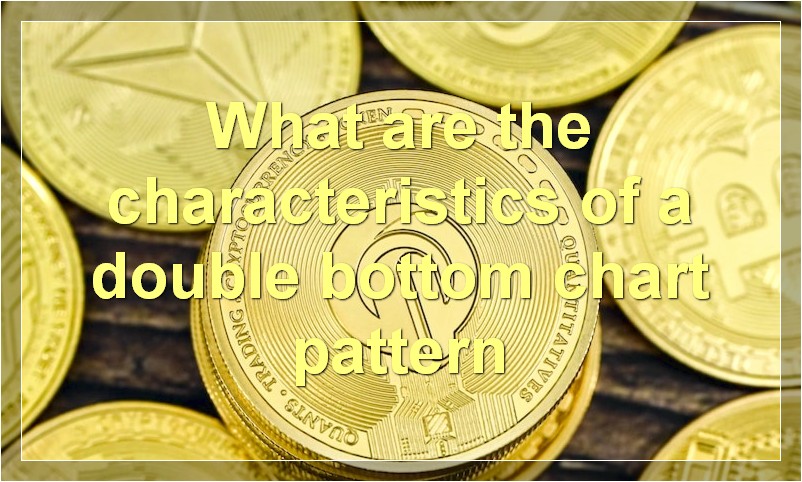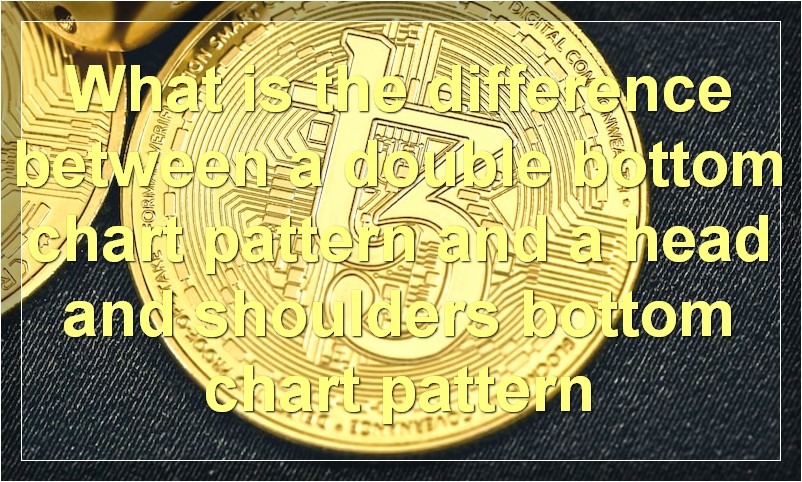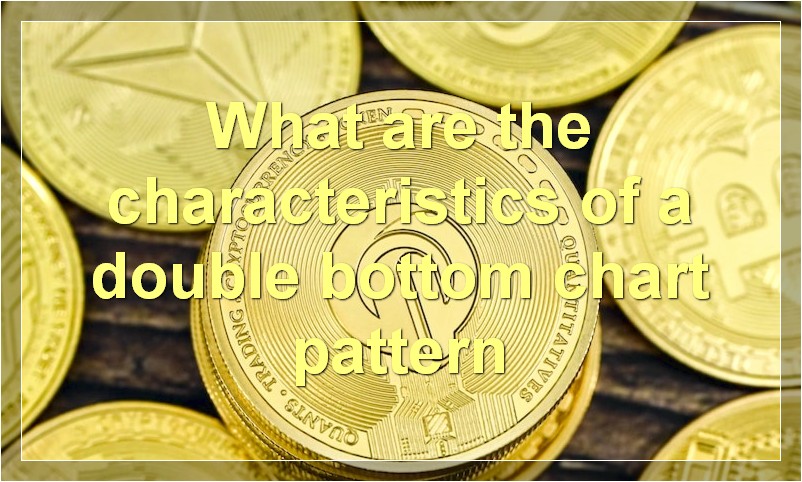If you’re looking to get ahead of the competition in the stock market, then you need to know about the double bottom chart pattern. This guide will show you everything you need to know about this powerful pattern so that you can start making money today.
What is a double bottom chart pattern
A double bottom chart pattern is a technical analysis term used to describe the reversal of a downward trend. It is characterized by two price valleys that are roughly equal, with a moderate peak in between them. The double bottom suggests that the selling pressure that pushed prices lower has been exhausted and that buyers are now willing to step in and support the stock at these levels.
The double bottom pattern can be found on any time frame chart, but is most commonly used on daily or weekly charts. It can be a very useful tool for swing traders and investors alike, as it can help you identify when a stock is ready to reverse its trend and start moving higher.
If you see a double bottom pattern forming on a chart, it’s important to wait for confirmation before taking any action. The best way to confirm the pattern is to wait for the stock to close above the peak that forms between the two lows. This peak is known as the “confirmation point.” Once the stock closes above this level, it’s a good indication that the double bottom pattern is valid and that the stock is likely to start moving higher.
What are the characteristics of a double bottom chart pattern

There are a few things to look for when identifying a double bottom chart pattern. First, you want to see a significant dip in price followed by a rebound. Second, the second dip should be shallower than the first, and third, there should be an uptrend leading up to the first dip.
If you see a chart that looks like this, it’s a good indication that a double bottom is forming. This type of pattern is typically seen as a bullish sign, as it indicates that buyers are stepping in after each dip.
While double bottoms can be helpful in identifying potential reversals, it’s important to remember that they are not foolproof. There’s no guarantee that price will continue to move higher after forming this pattern. However, if you see a well-defined double bottom on a chart, it’s worth paying attention to.
How do you identify a double bottom chart pattern
A double bottom chart pattern is considered a bullish reversal formation that happens after a prolonged downtrend. The “double bottom” is created when the price tests the support level twice and creates two distinct lows. The second low is typically lower than the first but not always. A trader might consider entering a long position after the price closes above the neckline.
The pattern is created when there are two consecutive lows followed by a higher high. The highs don’t have to be equal but they should be relatively close in price. The volume is an important factor in this pattern as well; ideally, it should be higher during the second low as buyers step in.
What is the significance of a double bottom chart pattern
The double bottom chart pattern is a technical analysis tool that is used to predict future price movements after the formation of two consecutive lows. The double bottom pattern is created when there are two successive lows followed by a higher low. The double bottom chart pattern is significant because it is often seen as a reversal pattern, which means that it can be used to predict that the price of a security will start to increase after it forms.
What is the difference between a double bottom chart pattern and a triple bottom chart pattern
The main difference between a double bottom chart pattern and a triple bottom chart pattern is the number of times the price reaches the support level. In a double bottom chart pattern, the price reaches the support level twice before starting to rise again. In a triple bottom chart pattern, the price reaches the support level three times before starting to rise again.
The double bottom chart pattern is considered to be a bullish reversal pattern, while the triple bottom chart pattern is considered to be a more reliable bullish reversal pattern. This is because it takes more than one test of the support level to form a triple bottom chart pattern, which suggests that there is stronger buying pressure at this level.
What is the difference between a double bottom chart pattern and a head and shoulders bottom chart pattern

There are two types of chart patterns that are used to predict reversals in a downtrend: double bottom and head and shoulders. Both patterns indicate that the selling pressure is exhausted and that the stock is likely to move higher.
The double bottom pattern is created when the stock price falls to a support level, bounces back up, and then falls again to the same support level. This creates a “W” shape on the chart. The head and shoulders bottom pattern is created when the stock price falls to a support level, bounces back up, and then falls again to a lower support level. This creates an “H” shape on the chart.
The main difference between these two patterns is that the head and shoulders bottom pattern has a lower low in the middle of the pattern, while the double bottom pattern has two equal lows. The head and shoulders bottom pattern is considered to be more reliable, since it takes two attempts for the stock price to fall to the same support level (indicating that the selling pressure is truly exhausted).
What are some trading strategies for a double bottom chart pattern
A double bottom chart pattern is a technical analysis indicator that predicts a bullish reversal in a stock’s price. The pattern is created when the stock’s price hits a support level twice and bounces off it both times.
There are a few different trading strategies that can be used when trading a double bottom chart pattern. One strategy is to buy the stock when the price breaks above the resistance level, which is the level at which the stock bounced off both times. Another strategy is to wait for the stock to confirm the pattern by closing above the resistance level. This confirmation usually comes in the form of a strong up day or two.
Once a double bottom chart pattern is confirmed, it’s important to place a stop-loss order below the support level to protect against a potential downside move. As for profit targets, some traders will take profits once the stock hits the resistance level again, while others may hold on for a larger move higher.
The key with any technical analysis indicator is to use it in conjunction with other factors, such as price action and volume, to make more informed trading decisions.
What are some common mistakes traders make with double bottom chart patterns
One common mistake that traders make with double bottom chart patterns is failing to identify the second low. This can lead to getting into a trade too early, before the pattern has fully formed, and taking a loss. Another mistake is not waiting for confirmation of the breakout above the neckline before entering a trade. This can lead to false breakouts and losses. Finally, traders may also enter too late, after the breakout has already occurred and the potential profit has been taken by other traders.
How can you use a double bottom chart pattern in conjunction with other technical indicators
When it comes to technical analysis, there are a variety of different indicators that can be used in order to gain a better understanding of the market. One of the more popular indicators is the double bottom chart pattern. This particular pattern is created when the price of an asset creates two distinct lows, followed by a rebound. The double bottom chart pattern is often seen as a bullish signal, as it indicates that the market has found support at this level.
In order to make the most out of this particular pattern, it is often recommended that traders use it in conjunction with other technical indicators. For example, many traders will look for the double bottom pattern to form after a period of downward momentum. This can be confirmed using indicators such as the Relative Strength Index (RSI) or the Moving Average Convergence Divergence (MACD). Once these indicators have been used to confirm the presence of downward momentum, traders can then look for the double bottom chart pattern to form.
Another way to use the double bottom chart pattern is in conjunction with trend lines. In many cases, the double bottom pattern will form near a previous support or resistance level. By using trend lines, traders can pinpoint these levels and then look for the double bottom pattern to form in close proximity to them. This can be used as a confirmation that the market has indeed found support or resistance at this level.
The double bottom chart pattern can be a useful tool for traders who are looking to get a better understanding of the market. However, it is important to remember that this pattern should not be used in isolation. Instead, traders should look to use it in conjunction with other technical indicators in order to confirm its reliability.
Are there any dangers in trading a double bottom chart pattern
A double bottom chart pattern is when the price of a security hits a low, bounces back up, and then hits that same low again. This second low is usually lower than the first one, but not always. The double bottom chart pattern is considered bullish because after hitting that second low, the price usually starts to head back up.
There are a few dangers to trading a double bottom chart pattern. One is that sometimes the second low is not actually lower than the first one. This can lead to false signals and losses. Another danger is that even if the second low is lower than the first one, the price might not start heading back up right away. It could take a little while for the uptrend to start, during which time you might have already sold your position.

